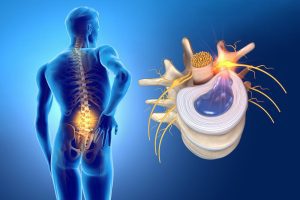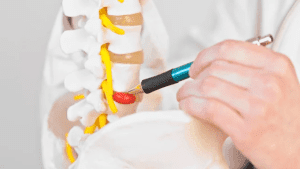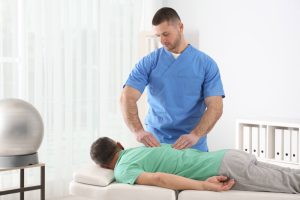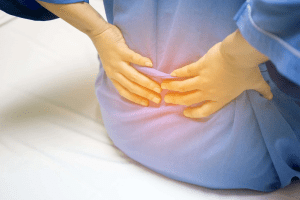Treatments for herniated disc at a pain management clinic
Painmed provides the most effective treatments for herniated discs, slipped discs, and bulging discs. This condition causes neck, back, and leg pain. Having a herniated disk can result in pain, weakness, and numbness in your neck, back, arms, and legs. There are times when these symptoms are severe enough to disrupt your life. In most cases, however, your herniated disk problems should resolve on their own within a few weeks. Feel better in the meantime by trying one or more of these treatments.
Taking a break
You should take it easy for a few days. By resting, you can reduce swelling and allow your back to heal. Avoid bending or lifting while your back hurts. You might be advised to rest in bed by your doctor. Bed rest is fine for a short period of time, but don’t stay off your feet for more than a couple of days. Keeping your joints and muscles moving will keep them from stiffening.
Heat and ice can also help relieve your pain. Place an ice pack or a warm wet towel on the sore area of your back. The temperature can be alternated between hot and cold, or you can use whatever feels most comfortable to you.
Medicines
Ibuprofen (Motrin, Advil) or naproxen (Aleve, Naprosyn) are over-the-counter pain relievers. Pain and swelling can be reduced with these medicines. You shouldn’t use these for more than 10 days without consulting your doctor. In large doses or for a long time, nonsteroidal anti-inflammatory drugs (NSAIDs) can cause heart problems and bleed.
If over-the-counter meds do not relieve your pain, your doctor may prescribe narcotics such as codeine or oxycodone-acetaminophen (Percocet).
To ease muscle spasms in your back, your doctor may prescribe muscle relaxants. Nerve pain medicines such as amitriptyline (Elavil, Vanatrip), duloxetine (Cymbalta), gabapentin (Neurontin), pregabalin (Lyrica), and tramadol (Ultram) can ease nerve damage pain.
Physiotherapy
Herniated disc symptoms can be improved with some exercises. It is possible to learn which exercises strengthen the muscles that support your back from a physical therapist. The following are also included in physical therapy programs:
- Flexibility exercises to keep your muscles flexible
- Walking or riding a stationary bicycle are aerobic exercises
- Massage
- Heat and ice
- The use of ultrasound
- Muscle stimulation with electricity
Taking injections
Your doctor can inject steroid medicine into the space around your spinal nerve if rest, pain relievers, and physical therapy don’t relieve your pain. An epidural injection is what this is called. As a result of the steroid, you may be able to reduce swelling, move more easily, and suffer less pain from a herniated disk. To find the right spot to inject the medicine, your doctor will use an X-ray or CT scan. Pain relief might require more than one steroid shot.
Surgical procedures
The majority of people with herniated discs do not need surgery. Your symptoms should begin to improve after 4 to 6 weeks of rest and other herniated disc treatments. If your pain does not improve, surgery might be an option. Consult your doctor if you are experiencing any of the following symptoms:
- Pain relievers, injections, and physical therapy don’t work.
- There is no improvement in your symptoms.
- Standing or walking is difficult for you.
- Bowels and bladders cannot be controlled.
Diskectomy. The purpose of this procedure is to relieve pressure on your nerves by removing your damaged disk. The surgery can be performed in two ways:
- Through a cut in your back or neck, your surgeon performs an open diskectomy.
- Microdiscectomy involves a much smaller incision. To remove the damaged disk, your surgeon inserts a thin tube with a camera on one end.
Lumbar laminotomy. It is also possible that your surgeon will need to remove a small piece of bone called the lamina from the vertebra. Your spinal cord is protected by the lamina. By removing part or all of it, the surgeon can access the herniated disk. Additionally, it can relieve pressure on your nerves and eliminate leg pain and sciatica. During a diskectomy, the lamina can be removed. A separate surgery might be necessary to remove it.
Spinal fusion. To stabilize your spine after a diskectomy or laminotomy, your surgeon may fuse the two vertebrae on either side of the disk together. A spinal fusion is the result of this process. By fusing the two disks, you will prevent the bones from moving and experience no more pain.
Surgery on artificial disks. There are only a few people who are good candidates for artificial disk surgery, since it only works on certain disks in your lower back. If your doctor deems it necessary, they will replace your damaged disk with a plastic or metal one. Your spine will be more stable and you will be able to move more easily with the new disk.
Spine Protection
The majority of herniated discs heal on their own or with treatment. It is possible for them to happen again. Always sit and stand straight to protect your spine and prevent another herniated disk. Rest one foot on a stool or box if you must stand for a long time. Lifting anything heavy should be done with caution.
To pick it up, squat from your knees. Avoid bending at the waist. Your back is put under too much pressure. Maintain a healthy weight. Your back is more likely to be strained if you are overweight. Smoking is not a good idea. Hardening of the arteries can damage your spine’s disks.

Slipped disc treatment by a pain specialist
Slipped discs occur when the soft cushion of tissue between the bones in your spine pushes out. If it presses on nerves, it’s painful. Rest, gentle exercise and painkillers usually help.
Make sure it’s not a slipped disc
Slipped discs (also called prolapsed or herniated discs) can cause:
- Low back pain
- Feeling numb or tingly in your shoulders, back, arms, hands, legs, or feet
- Pain in the neck
- Your back hurts when you bend or straighten it
- Weakness of the muscles
- Sciatica is a pain in the buttocks, hips, or legs caused by a disc pressing on the sciatic nerve.
There are some slipped discs that do not cause symptoms. It is common for people to not realize they have slipped a disc until it is too late.
Back pain can also be caused by other factors
Occasionally, the pain is caused by an injury, such as a sprain or strain, but often there is no obvious cause. It is rare for back pain to be caused by anything serious. Self-care tips for easing the pain of a slipped disc:
Stay active
At first, you may need to rest if the pain is very bad. However, you should start gentle exercise as soon as possible – it will help you recover faster. It doesn’t matter what type of exercise you do, just gradually increase your level of activity.
Painkillers should be taken
Alternative painkillers include ibuprofen and paracetamol. Back pain should not be treated with paracetamol alone. Take them regularly (up to the recommended daily amount) rather than only when the pain is particularly severe. You will be able to keep moving this way.
Slipped discs can be treated by a pharmacist
The use of non-steroidal anti-inflammatory drugs (NSAIDs) like ibuprofen is not suitable for everyone. If you’re not sure, consult a pharmacist. For pain that has just begun, stronger painkillers containing codeine may be helpful. The use of these types of painkillers should be limited to a few days at a time to avoid addiction.
GP treatment for a slipped disc
For short-term pain relief, a GP might prescribe a stronger painkiller, a steroid injection, or a muscle relaxant. A GP may recommend further tests, such as an MRI scan if your symptoms do not improve. You might also be referred to a physiotherapist. NHS physiotherapy may not be available everywhere and waiting times can be long. It is also available privately.
Slipped disc surgery
Usually, surgery is not necessary, but a GP might refer you to a specialist if your symptoms include:
- Other slipped disc treatments have not improved their condition
- Numbness or muscle weakness may worsen
Slipped disc alternative treatments
Lower back pain may be relieved by manual therapies, like osteopathy. It is usually a private treatment that you will have to pay for.
Slipped discs: what causes them
There are several reasons why they can occur:
- The aging process
- Overexertion
- Lifting heavy objects incorrectly
- Driving or operating machinery can cause vibrations
- Being overweight or inactive
Bulging Disc treatment is provided by pain management clinics in Sydney
Spinal discs between vertebrae act as shock absorbers, preventing damage to spinal tissue and bone. Additionally, they facilitate movement. A disc is made up of a hard casing and a liquid-like center. When the disc moves or slips from its normal position, the fluid material swells outward throughout its weakest point. The disc balloons between the vertebrae in many cases. Over time, this process occurs. As a condition progresses, the symptoms will become more severe. Protruding discs can be referred to as bulging discs.
Bulging disc symptoms
The pain associated with a bulging disc may be minimal if it has not yet reached the stage of herniation. There is a possibility that a bulging disc does not cause any pain because it has not reached a certain stage of severity, and this may make it difficult to identify bulging disc symptoms before the condition worsens.
Bulging discs create pressure points on nearby nerves, causing a variety of sensations. A bulging disc can cause mild tingling and numbness to moderate or severe pain, depending on its severity. Bulging discs at this stage are usually near or at herniation when they reach this stage.
- There is tingling or pain in the fingers, hands, arms, neck, or shoulders. There may be a bulging disc in the cervical region causing this.
- There is a pain in the feet, thighs, lower spine, and buttocks. In the lumbar region, this is the most common symptom.
- Having difficulty walking or feeling impaired when lifting or holding things.
A potentially life-threatening condition may be causing these symptoms, which require immediate medical attention. Sciatic nerve pain usually affects one leg or the other, but not both. The nerves that control the bladder can be compressed by a bulging disc, resulting in bladder incontinence. If this occurs, seek emergency medical attention right away. A bulging disc in the mid-spine can cause upper back pain that radiates to the stomach or chest. Any bulging disc may also cause muscle spasms. Some patients may go years without exhibiting any symptoms, while others may suffer extreme or life-threatening consequences.
Bulging disc causes
In determining the cause of bulging discs, you, the client, maybe the best resource. You will be asked a series of questions about your lifestyle and your physical activity. In addition to natural aging and disc degeneration, other risk factors may also contribute to the condition. Over time, discs may become more vulnerable.
Bulging discs: potential causes
- Bulging discs are more likely to occur in people who lead sedentary lifestyles or smoke.
- As the discs age, continuous strain from injuries, heavy lifting, and strain can wear them down.
- A weakened back muscle can accelerate the process and cause a disc to herniate suddenly.
- Herniated discs may occur quickly by trauma, although bulging discs develop over time.
- Incorrect body positioning during sleep, sitting, standing, or exercise are all risk factors that may contribute to bulging discs.
- The obesity epidemic
- Sports or activities involving high contact are also risk factors.
- Bulging discs can also occur in runners who do not wear shoes with orthopedic support.
- Stress and strain on the spine can weaken the discs.
Bulging disc diagnosis
A thorough medical examination, including X-rays and in some cases CT or MRI scans, is necessary to diagnose bulging disc conditions accurately. Testing formats like these show changes in disc shape and condition.
Treatment for bulging discs
You should consider a few things before considering bulging disc treatments or herniated disc surgery, no matter how minimally invasive. For bulging disc symptoms or pain caused by the affected disc, patients should first change their body positioning and behaviors (sleeping, sitting, and posture positions). Slowing the progression of the disease may be possible by addressing causal factors.
- Obese patients can benefit from a healthy weight-reduction plan and exercise.
- To regain mobility and strengthen muscles in the back, a doctor may recommend physical therapy.
Bulging discs can be successfully managed with non-surgical treatments before they herniate. A variety of pain management options are available depending on the severity of the pain. Prescription and over-the-counter anti-inflammatory medications can relieve mild to moderate discomfort.
Pain symptoms can also be reduced by using heating pads, ice packs, massage therapy, and exercise. To support the affected area for a period of time, some physicians recommend taping or bracing. An emergency surgeon can perform surgery if the disc is causing life-threatening consequences, but this is rare.
Options for new treatments
In order to relieve pain, minimally invasive treatments are becoming more common, including endoscopic spine surgery. Bulging disc problems can be corrected by surgeons using minor surgical techniques. Post-procedure, patients may be advised to perform exercises to strengthen their back muscles. Depending on the extent of the problem and the type of issues caused by the bulging disc, a surgeon will perform a minimally invasive procedure.
Final Thoughts
Bulging discs are medical conditions that develop over time. Although it is more common with aging, it can also occur in younger people. Medical testing and scans that show changes in disc shape and positioning are the only ways to detect early symptoms. Before advanced disc bulging and herniation, some may experience sensations ranging from tingling to pain. The condition may be prevented from worsening if it is detected early. Contact us to speak with one of our specialists if you have any questions.
A list of frequently asked questions
If I don’t have surgery for my herniated disc, what happens?
Herniated disc material dissolved in most cases of herniated discs within six months to a year in a study of patients with different-sized herniations. Material reabsorbed faster with larger herniations (extrusions). While surgery may produce a faster initial recovery time, conservative (nonsurgical) outcomes are equally effective after five and ten years of follow-up
Slipped discs are associated with what risk factors?
You have a higher chance of lumbar disc herniation if you have the following risk factors. 30 – 50 years of age, Smoking, Overweight, History of back pain, Lack of exercise. Occupations or activities that require:
- A prolonged period of sitting or standing
- Forwards and backward bends
- The heavy lifting on a regular basis
- The vibration of the back, such as while driving
- Night shifts are frequent
Is it possible to prevent slipped discs?
Maintain a healthy weight, don’t smoke, exercise regularly, and Maintain the correct sitting and standing posture.
Why does a bulging disc hurt?
Bulging discs protrude beyond their normal boundaries. A bulging disc can cause pain by pressing against surrounding nerves.
A herniated or bulging disc can be diagnosed in several ways.
In order to diagnose the cause of your back pain, your doctor will ask you about your health history, perform a thorough examination, and may recommend an MRI or CT scan.


